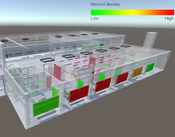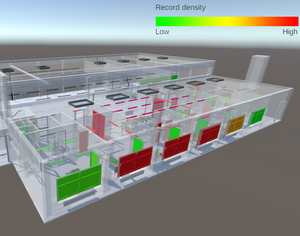Information
- Publication Type: Conference Paper
- Workgroup(s)/Project(s): not specified
- Date: 2021
- ISBN: 978-989-758-488-6
- Publisher: SciTePress
- Event: GRAPP 2021
- DOI: 10.5220/0010288902610270
- Booktitle: Proceedings of the 16th International Joint Conference on Computer Vision, Imaging and Computer Graphics Theory and Applications - GRAPP
- Pages: 10
- Pages: 261 – 270
- Keywords: Gamification, Building Monitoring, Building Information Modeling, Spatial Localization, 3D Visualization, Mobile Applications, Crowdsourcing
Abstract
For efficient facility management it is of high importance to monitor building information, such as energy consumption, indoor temperature, occupancy as well as changes in building structure. In this paper we present a novel methodology for monitoring information about building via gamification. In our approach, the employees of a facility record the states of building elements by playing a competitive mobile game. Traditionally, external sensors are used to automatically collect information about the building usage. In contrast to that, our methodology utilizes personal mobile phones of employees as sensors to identify objects of interest and report their state. Moreover, we propose to use crowdsourcing as a tool for data collection. This way the users of the mobile game are collecting points and compete with each other. At the end of the game the winning team gets the reward. We utilized various gamification strategies to increase motivation of users to collect building data. We ex tended the traditional 3D BIM model with temporal domain to enable tracking of building changes over time. Finally, we run an experiment with real use case building in which the employees used our system for the duration of three months. We studied our approach and our motivation strategies in a post-experiment study. Our results suggest that gamification can be a viable tool for building information monitoring. Additionally, we note that motivation plays a critical role in the data acquisition by gamification.Additional Files and Images
Additional images and videos
 model:
Building information monitoring via gamification - web visualization of measured building properties
model:
Building information monitoring via gamification - web visualization of measured building properties
Additional files
Weblinks
- Paper link
- Entry in reposiTUm (TU Wien Publication Database)
- Entry in the publication database of TU-Wien
- DOI: 10.5220/0010288902610270
BibTeX
@inproceedings{Kan_Peter-2021-BuildingMonitoring,
title = "Building Information Monitoring via Gamification",
author = "Peter K\'{a}n and Peter Ferschin and Meliha Honic and Iva
Kovacic",
year = "2021",
abstract = "For efficient facility management it is of high importance
to monitor building information, such as energy consumption,
indoor temperature, occupancy as well as changes in building
structure. In this paper we present a novel methodology for
monitoring information about building via gamification. In
our approach, the employees of a facility record the states
of building elements by playing a competitive mobile game.
Traditionally, external sensors are used to automatically
collect information about the building usage. In contrast to
that, our methodology utilizes personal mobile phones of
employees as sensors to identify objects of interest and
report their state. Moreover, we propose to use
crowdsourcing as a tool for data collection. This way the
users of the mobile game are collecting points and compete
with each other. At the end of the game the winning team
gets the reward. We utilized various gamification strategies
to increase motivation of users to collect building data. We
ex tended the traditional 3D BIM model with temporal domain
to enable tracking of building changes over time. Finally,
we run an experiment with real use case building in which
the employees used our system for the duration of three
months. We studied our approach and our motivation
strategies in a post-experiment study. Our results suggest
that gamification can be a viable tool for building
information monitoring. Additionally, we note that
motivation plays a critical role in the data acquisition by
gamification.",
isbn = "978-989-758-488-6",
publisher = "SciTePress",
event = "GRAPP 2021",
doi = "10.5220/0010288902610270",
booktitle = "Proceedings of the 16th International Joint Conference on
Computer Vision, Imaging and Computer Graphics Theory and
Applications - GRAPP",
pages = "10",
pages = "261--270",
keywords = "Gamification, Building Monitoring, Building Information
Modeling, Spatial Localization, 3D Visualization, Mobile
Applications, Crowdsourcing",
URL = "https://www.cg.tuwien.ac.at/research/publications/2021/Kan_Peter-2021-BuildingMonitoring/",
}

